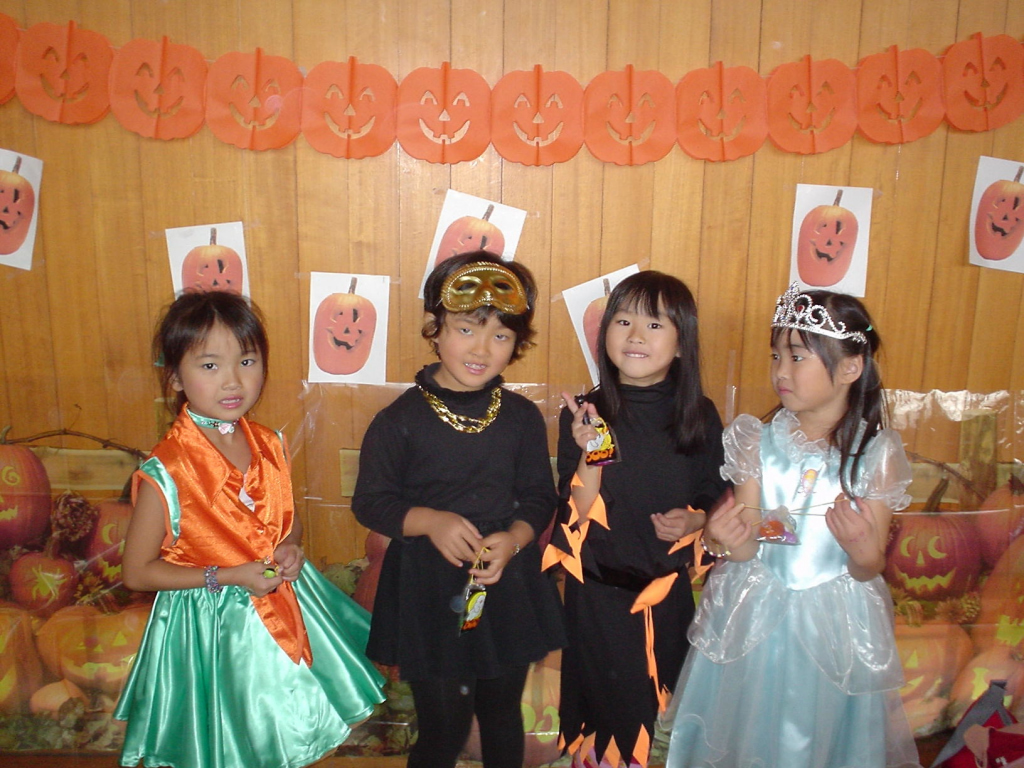by Brett Iimura and Iona Macnab
These days Halloween is celebrated by people around the world, who enjoy dressing up in colorful costumes before hitting the town on October 31. But we often forget that the holiday has a long, colorful and tangled history, combining ancient Celtic festivities with Christian ones, which have evolved over time into the huge, mostly commercial festival we now know.
October 31 was the night before the Celtic new year, when the end of the harvest was celebrated with bonfires. The ancient Celts believed that on this night, the boundary between the living and the deceased became blurred, and there was a risk to the living from evil spirits. In ancient times they used masks and costumes to trick the spirits, and scary faces carved into turnips were placed in the windows of homes. Most celebrations held around the world at the end of October were a combination of seasonal festivities and religious or superstitious ones, and each country’s customs evolved over time but with a common dark theme as they approached the winter, and the threat of death from cold or famine.
Where did the name Halloween come from?
The celebration of All Saints Day (originally All Hallows Day) on November 1 led to the naming of Halloween. Occurring the night before, it was known as All Hallows’ E’en (evening), which was then shortened to Hallowe’en. In many countries All Saints Day and All Souls Day are celebrated on November 1 and 2, many with festivities commemorating the dead. The significance and customs of these events vary by country.
Where does the custom of ‘trick-or-treating’ come from?
As Europeans began migrating to the United States, they took their various Halloween celebrations with them, including the Irish custom of dressing in costumes and going door to door asking for food or money. This evolved into the ‘trick or treat’ custom we know today, where children dressed in costumes go around their neighborhoods collecting candy (‘treats’) or threatening to cause some minor mischief to the householder who refused to give candy (‘tricks’). In the late 1800s there was a movement in the US to make Halloween a more community-centered festival, and most of the superstitious and religious overtones have been lost. Parties and town parades became more common, and were combined with the celebrations of the end of the seasonal harvest.
Why do people carve pumpkins on Halloween?
Europeans were accustomed to carving turnips to scare away evil spirits. There is also an Irish legend about Stingy Jack, who tried to trick the devil. After he died he was then banished to wandering around in the afterlife with only a small candle inside a carved turnip-lantern. Pumpkins are native to America, and the Europeans found them plentiful and easier to carve than turnips.
Halloween Comes to Japan
Over the years Halloween has become more and more popular here in Japan. There are some similarities to the Japanese celebration of obon, during which the spirits of deceased family members are said to return, and people visit cemeteries and give offerings of food.
Halloween Events in Tokyo
• Tokyo Disney Resort has huge Halloween parades each day from September 10 to November 3, as well as lots of other Halloween themed activities and shows. More details about times and locations can be found at www.tokyodisneyresort.co.jp.
• Sanrio Puroland’s Halloween Festival takes place from October 9–31. There will also be free admission from 3pm on October 24 and 25 for people dressed in Sanrio character Halloween costumes. Check www.puroland.co.jp/event/2009autumn/hw.html (Japanese only).
• Some 25 years ago Kiddyland in Harajuku began a small Halloween parade. The Hello Halloween Pumpkin Parade has grown over the years and will see hundreds of families, both Japanese and international, dressed in costumes. This year it will be held on Sunday, October 25 from 11am along Omotesando-dori in Harajuku. Costumes are amazing in Harajuku on a regular weekend, with all kinds of gothic and Lolita types to be found, so just imagine Halloween! Kids in costumes get free treats from participating stores. Details are available here: www.harajuku-halloween.com
Halloween Supplies
Decorations are available in almost all major department stores these days, with Tokyu Hands and Loft in Shibuya both stocking large collections. Candies in bulk are available from both Japanese and imported brands, as the commercialization of Halloween in Japan has spread. Imported Halloween decorations, costumes, pumpkins for carving, candy in bulk, Halloween themed CDs and DVDs, games and treats can be purchased from the Foreign Buyers Club (www.fbcusa.com/cs) and National Supermarket in Azabu and its sister store Den-en Supermarket in Den-en Chofu.
Parenting Tip: Pumpkin Carving
For suggested designs and instructions, visit the comprehensive site www.pumpkin-carving.com. It has photographic instructions for beginners through to complex stenciled designs for the more advanced carver. Glow sticks are suggested for illuminating your pumpkin if you prefer to avoid flames from candles and tea lights. Helpful Halloween safety tips provided by the American Academy of Pediatrics can be found here: www.aap.org/advocacy/releases/octhalloween.cfm
Brett Iimura ICCE, mother of two, is the director of the Childbirth Education Center (CEC), serving parents-to-be throughout Japan since 1997. Iona Macnab IBCLC is a lactation consultant in private practice in Tokyo and a mother of three. They have over thirty years of combined experience in Japan, and much experience raising bilingual, bicultural children!
Updated On April 26, 2021










